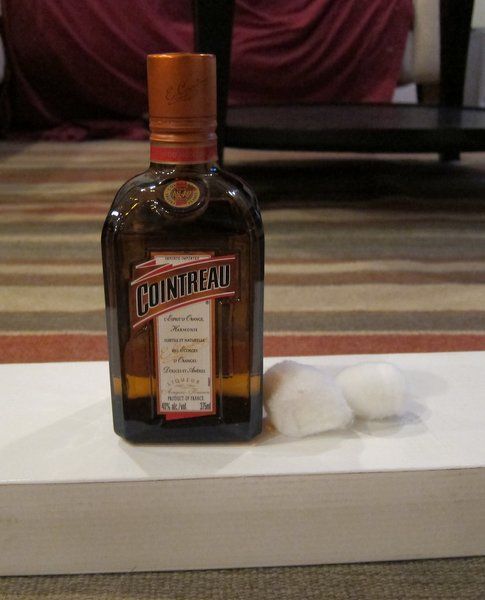At the beginning of the month, I decided that my next seasonal trick was going to be teaching Dog Mob to make Cinco de Mayo margaritas. I announced this on April 1 so, understandably, a lot of my friends thought I was joking and it was an April Fool's gag.
But nope, I meant it. Of course Dog Mob can't literally make margaritas because they have no hands, and while it is possible to get a dog to open a screw-top bottle, any liquor bottle big enough for Pongu to get a decent grip on the top would also be too big for him to lift and pour. So actual margarita making was off the table.
What we did instead was a series of scent discrimination and object targeting exercises. Here's the finished version:
And here's how we got there...
Step 1: Scent Recognition
The first step was for Dog Mob to be able to distinguish one liquor bottle from another. They can't read labels, and the bottles' appearances are sufficiently similar that they had a hard time with purely visual recognition (however, the plastic lime looks different enough from the other mixers that Pongu could identify that one by sight, so that portion of the trick is based on visual recognition).
In my experience, the easiest way to teach scent recognition to a dog who has no prior familiarity with that exercise is to rub a bit of smelly food on the article to be identified. Food smells are inherently interesting, so it's easy for a dog to pick out the object that smells like cheese or hot dog juice or whatever else you're using. Once the concept is clearly understood, you can use different scents and have the dog identify those.
I got it in my head that it would be pretty funny if I could teach Dog Mob to identify different liquors by scent, so for this trick, I dabbed a little bit of the relevant liquors onto a cottonball and then dabbed the cottonball onto the paper labels, figuring that would hold the scent better than the glass bottle. Really, dogs' noses are good enough that I'm sure they'd be able to find it on the bottle too, but I did it this way anyhow.
After waiting a couple of minutes for the alcohol to evaporate (otherwise it acted as a mild aversive, as I discovered when I asked Pongu to pick up the tequila bottle too soon after dabbing it), I invited Dog Mob to sniff the bottles. Any contact to the scented object got a click and treat.
Step 2: Paw Touch/Directed Retrieve - Single Object
Next, I put the scented article on a platform by itself and asked the dog to either retrieve the object (for the lime and tequila bottle) or mark it with a paw touch if it was too big to retrieve (Cointreau bottle, sugar box, salt container). Both dogs already knew these actions, so I didn't have to shape the movements from scratch; it was just a matter of getting them to target the intended objects. So we practiced it a few times, and each correct gesture earned a click and a treat. Once the dog was doing the correct motion with no hesitation, we moved on.
Step 3: Selecting Correct Object
The third step was for the dog to be able to select the correct object from a lineup of dummy objects. For Crookytail, who was new to this sort of thing, I started with just one dummy and one correct object, then slowly worked up to two dummies and one correct object. Pongu is more experienced with object discrimination exercises, so I started him on multiple dummies right away.
At this stage, picking the wrong object gets a NRM and an invitation to re-try, while every correct answer is given a click and treat.
For the salt/sugar "what goes on the rim?" question, I wanted each dog to select a different answer, so I put the other dog's answer in the lineup too and treated it as a dummy (i.e., Crookytail was asked to choose between the sugar box and the salt container, and rewarded only for choosing the sugar box; vice versa for Pongu).
Step 4: Putting It All Together
From there, all that was left was putting the whole thing together.
The final version of the margarita trick is done exclusively with off-camera hand gestures. Other than each dog being released from Stay by name in the last segment, there are no verbal cues, because my attempts to work verbals into the dialogue resulted in both dogs anticipating the cues and doing the exercises as soon as I started talking, instead of waiting until they appeared to be responding to my questions. So instead of giving them verbal cues, I used a very simple system of "stop/move" hand gestures for both dogs. The only cue I'm giving tells them when to move and when to stop; everything else is determined by the context and props.
I also realized that for the last segment, I had to release Crookytail first, because he is so used to holding a Stay while Pongu works that he wouldn't budge once Pongu moved. Unless I specifically asked him to do something, and asked him first, Crooky thought that, as usual, his job was just to keep out of the way. So, again, we adjusted the sequencing a little to achieve the desired effect. (I probably could have gotten it to go the other way eventually, but for a jokey thing like this, why?)
And that's how we did the margarita trick.


So cool! and I, too, now know what goes in a Margarita. Thanks, Dog Mob.
ReplyDeleteVery welcome, and glad you enjoyed it! :)
ReplyDelete